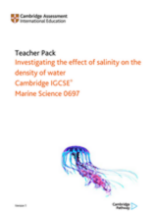The moisture content of sand or sediments on a shoreline is an important abiotic factor for organisms in intertidal zones. In this investigation you will investigate the moisture content of samples from different places on shore.
Samples of sand or sediments should be collected from different points on the shore, ideally near the low tide mark, high tide mark and a range of locations between.
These should be collected in advance of the practical lesson and the samples labelled and stored with sealed lids to prevent water evaporating from the samples. If stored longer than a few hours they can be kept in the fridge before the practical to return any evaporated moisture to the sediments.
To obtain precise results you must use a balance that measures to at least 0.1 g increments.
Label a clean dry evaporating dish with the location of the first sample.
Zero or tare an electronic balance. Place the labelled evaporating dish on to the balance. Record this mass in a results table.
Add approximately 20 g of sediment to the evaporating dish. Record the exact mass of the evaporating dish and the sediments in the results table. We can use these first two masses later to calculate the mass of sediments we have added.
Place the evaporating dish in an oven set at around 50 oC.
Repeat this process for the sediments collected from other locations on the shore.
Leave the samples in the oven overnight.
The following day, remove each sample from the oven, taking care not to burn yourself on the hot evaporating dishes.
Record the mass of each set of dry sediments in the evaporating dishes.
Calculate the mass of the wet sediments for each sample by subtracting the mass of the dry evaporating dish (in column A) from the mass of the evaporating dish containing the wet sediments (in column B).
Calculate the mass of water lost from each sample by subtracting the mass of the dish containing dry sediments (in column C) from the mass of the evaporating dish containing the wet sediments (in column B).
Finally, calculate the percentage moisture content by diving the mass of water lost (in column E) by the mass of wet sediments (in column D) and multiplying this value by 100 to make it a percentage.
To check the reliability of the results, samples at each location can be retested and a mean calculated for each location.
If there are several groups collecting the results from the same samples you could compare your results with those obtained by other groups.
Many organisms depend on sediments on a shore retaining moisture at low tide to prevent them drying out. Do your results show that the sediments near the low tide have retained more or less moisture than the sediments nearer the high tide mark?
 Moisture content video transcript
The moisture content of sand or sediments on a shoreline is an important abiotic factor for organisms in intertidal zones. In this investigation you will investigate the moisture content of samples from different places on shore. Samples of sand or sediments should be collected from different points on the shore, ideally near the low tide mark, high tide mark and a range of locations between.
Moisture content video transcript
The moisture content of sand or sediments on a shoreline is an important abiotic factor for organisms in intertidal zones. In this investigation you will investigate the moisture content of samples from different places on shore. Samples of sand or sediments should be collected from different points on the shore, ideally near the low tide mark, high tide mark and a range of locations between.